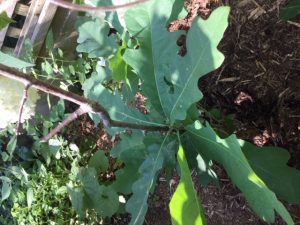
I have two new small oak trees that are growing new branches from the lower part of the trunk. My garden faces the Humber River and is surrounded by many oaks, so I know I have suitable conditions for these trees. I planted them with compost, they are mulched and I have irrigation. It appears that the top of the trunk/main stem has died back, but new healthy foliage is definitely growing from small stems coming off the lower portion of the main stem. Should I trim back the dead portion and let these trees grow, or will this cause them to be misshapen? Thank you in advance for your insight.
Thank you for contacting the Toronto Master Gardeners with your query concerning your newly planted oak trees.
You don’t mention if these trees were planted this spring or did you plant them last summer? If your trees were planted this year and purchased from a reptutable nursery then I would return the trees. Most garden centers have one year guarantee on plants so even if they were purchased last year you can exchange them for new trees. Some garden centers have a two year guarantee on plants.
You mention that you added compost when planting the trees. Did you add compost to the hole ? Ideally you should not add new bags of soil or soil amendments when planting a tree. The following information is from our Gardening Guide, Planting a Tree, It may seem nurturing to add new top soil, manure, compost or peat moss to enhance the soil, but in fact, you are creating a soil pocket which is unlike the surrounding soil. The roots may initially grow well, but, as they come to the edge of the soil in the planting pocket, they will resist growing beyond into the surrounding soil. The tree will be stronger and grow faster if its roots are able to adapt quickly to the given soil conditions and begin to grow out and down into the earth beyond the prepared hole. If you would like to improve the soil, do so gradually by using organic amendments, such as a layer of disease free leaves, in the form of a mulch. Spread mulch around the surface of the soil after the tree is planted, so it will slowly and naturally decompose and work its way into the soil.
Root stress is among the most likely reason that the top of your tree died. A tree tries to find a balance between the top and below ground system. Was there recent construction near where you planted the tree? Soil compaction? Both of these factors can lead towards root stress. Another factor are girdling roots, this is when the roots coil around the base and constrict the flow of sap. This can happen when trees are grown in containers, and the problem is exacerbated when they are brought home from the nursery and planted too deep. The following is from our gardening Guide- The importance of planting a tree at the correct depth cannot be overemphasized. Planting too deeply will eventually lead to the death of the tree. The place where the roots meet the trunk is called the trunk flare or the root collar. Unlike roots, trunks are not meant to be buried in soil. If covered in soil the trunk may rot, become diseased or even die. The tree must be placed in the ground so that the soil grade is level with the bottom of the root collar. When planted at the proper level you will see the gentle flare of the trunk rise just above the soil line. Err on the side of placing the tree higher above the soil, especially if you suspect the soil will settle and the tree will sink. It is easier to add soil after planting, than to replant a tree with a sunken trunk flare.
Suckers are a tree’s attempt to grow more branches, often in response to some kind of injury- soil compaction, girdling roots, pest. If you decide to cut of the dead portion of the tree your tree will no longer have a trunk and will appear more as a shrub than a tree with a defined trunk.

